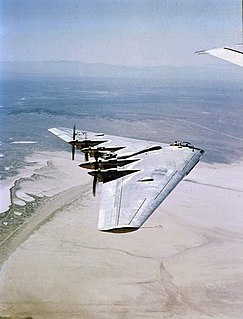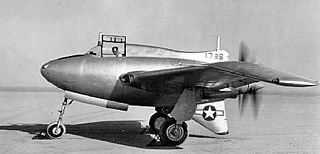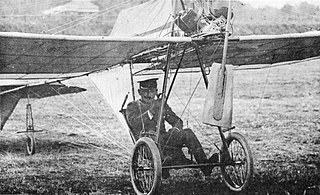
The DFS 194 was a rocket-powered aircraft designed by Alexander Lippisch at the Deutsche Forschungsanstalt für Segelflug.

The Northrop XB-35 and YB-35, Northrop designation N-9 or NS-9, were experimental heavy bomber aircraft developed by the Northrop Corporation for the United States Army Air Forces during and shortly after World War II. The airplane used the radical and potentially very efficient flying wing design, in which the tail section and fuselage are eliminated and all payload is carried in a thick wing. Only prototypes and pre-production aircraft were built, although interest remained strong enough to warrant further development of the design as a jet bomber, under the designation YB-49.

The Northrop X-4 Bantam was a prototype small twinjet aircraft manufactured by Northrop Corporation in 1948. It had no horizontal tail surfaces, depending instead on combined elevator and aileron control surfaces for control in pitch and roll attitudes, almost exactly in the manner of the similar-format, rocket-powered Messerschmitt Me 163 of Nazi Germany's Luftwaffe. Some aerodynamicists had proposed that eliminating the horizontal tail would also do away with stability problems at fast speeds resulting from the interaction of supersonic shock waves from the wings and the horizontal stabilizers. The idea had merit, but the flight control systems of that time prevented the X-4 from achieving any success.

The Northrop N-1M, also known by the nickname "Jeep", is a retired American experimental aircraft used in the development of the flying wing concept by Northrop Aircraft during the 1940s.

The Northrop XP-56 Black Bullet was a unique prototype fighter interceptor built by the Northrop Corporation. It was one of the most radical of the experimental aircraft built during World War II. Ultimately, it was unsuccessful and did not enter production.

The Lockheed Altair was a single-engined sport aircraft of the 1930s. It was a development of the Lockheed Sirius with a retractable undercarriage, and was the first Lockheed aircraft and one of the first aircraft designs with a fully retractable undercarriage.

The Short SB.4 Sherpa was an experimental aircraft designed and produced by the British aircraft manufacturer Short Brothers. Only a single example was ever produced.

The General Aircraft GAL.56 was a family of 1940s British experimental tailless swept wing glider designs.

The Kayaba Ku-2 was a glider built in Japan in 1940 to investigate the possibilities of tailless aircraft. It was developed as part of an Imperial Japanese Army contract that had been offered to designer Hidemasa Kimura following the successful flights of his HK-1 tailless glider over the previous years.
The Kayaba Ku-3 was a glider built in Japan in 1941 to investigate the possibilities of tailless aircraft. Building on the success of the Ku-2 design of the previous year, the Ku-3 was a substantially larger aircraft with several novel features. The small vertical fins of the Ku-2 were abandoned, leaving the Ku-3 with no vertical control surfaces. The crescent wing had three pairs of control surfaces on the trailing edge. The outer, less-swept wing sections had a greater dihedral than the inner sections.

The Kayaba Ka-1 and Ka-2 were Japanese autogyros, seeing service during World War II for artillery spotting.

The Kellett KD-1 was a 1930s American autogyro built by the Kellett Autogiro Company. It had the distinction of being the first practical rotary-wing aircraft used by the United States Army and inaugurated the first scheduled air-mail service using a rotary-wing aircraft.

The Kimura HK-1 was a glider built in Japan in 1939 to investigate the possibilities of tailless aircraft. It was a single-seat design with an open cockpit, swept wings, and a single tail fin. The HK-1 made a total of 169 test flights between 15 December 1939 and 7 March 1940, towed aloft behind a car.

Kumazō Hino was a Japanese inventor and aviation pioneer. His most famous invention is the M1908 pistol.

The Heinkel He P.1079 was a projected German V-tail all weather jet fighter designed by Heinkel Flugzeugwerke in the closing stages of World War II. The aircraft was only a design; it was not produced.
The NRC tailless glider, also called the NRL tailless glider, was a two-seat tailless research glider designed by the National Research Council of Canada and built by the National Research Laboratories, at the instigation of G.T.R. Hill who had previously designed the British Westland-Hill Pterodactyl series of tailless aircraft.

The Kayaba Heliplane Type-1 was a gyrodyne designed by Shiro Kayaba and prototyped by Kayaba Industry in Japan during the early 1950s.

The Horten H.VII was a flying wing fighter-trainer aircraft designed by the Horten brothers in Nazi Germany during World War II.
















